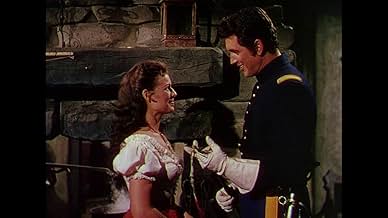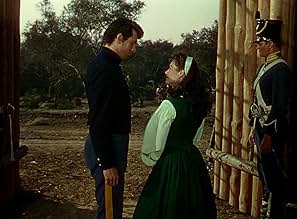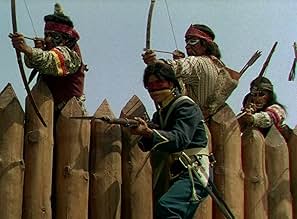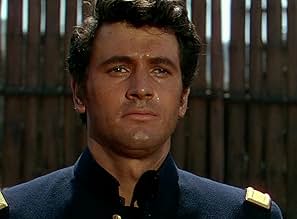NOTE IMDb
6,2/10
1,4 k
MA NOTE
Lorsqu'il apprend le projet d'extermination d'une tribu amérindienne en Floride, le lieutenant Caldwell tente de convaincre son supérieur de la cruauté de cet acte.Lorsqu'il apprend le projet d'extermination d'une tribu amérindienne en Floride, le lieutenant Caldwell tente de convaincre son supérieur de la cruauté de cet acte.Lorsqu'il apprend le projet d'extermination d'une tribu amérindienne en Floride, le lieutenant Caldwell tente de convaincre son supérieur de la cruauté de cet acte.
- Réalisation
- Scénario
- Casting principal
John Daheim
- Scott
- (as John Day)
Carl Andre
- Trooper
- (non crédité)
Ray Beltram
- Indian
- (non crédité)
Chris Willow Bird
- Indian
- (non crédité)
Eumenio Blanco
- Indian
- (non crédité)
Robert Bray
- Capt. Sibley
- (non crédité)
Frank Chase
- Trooper
- (non crédité)
Dick Cherney
- Trooper
- (non crédité)
Avis à la une
Most people, especially in the future, will see the credits, and miss a lot of the plot simply looking for the Professor. Russell Johnson barely appears.
This is a fairly decent adventure. It's tempting to call it a Western, but technically that would be hard to do. It's West of Europe, but the location of Florida is more of a "Southern".
Still, this is a basic Western adventure. We have the hero struggling against a thick headed officer in handling the local natives.
The truth be known, most Westerns of the golden era were like this, depicting the native Americans as basically honorable and victims of corrupt white men. Here, we get the super honorable natives, and a few honorable white men, trying to "do the right thing" with a few malcontents messing things up.
What sets this above the average "western" or "southern version of a Western", is the famous battle scene. This was one of the most dramatic skirmish scenes ever filmed. It involves about twenty five soldiers against hidden natives, who do appear from hiding to attack. It is well blocked, and very exciting. It ranks as one of the most memorable battle scenes ever.
The journey through the swamp is also well done, and dramatic.
Aside from that, the story is a little routine. Sme major stars, and a beautiful woman add to the attraction.
This is a fairly well done film, that should rank moderately over a "5" in a realistic rating. Not as slow paced as most modern movies, but not as fast paced as most golden age Westerns.
This is a fairly decent adventure. It's tempting to call it a Western, but technically that would be hard to do. It's West of Europe, but the location of Florida is more of a "Southern".
Still, this is a basic Western adventure. We have the hero struggling against a thick headed officer in handling the local natives.
The truth be known, most Westerns of the golden era were like this, depicting the native Americans as basically honorable and victims of corrupt white men. Here, we get the super honorable natives, and a few honorable white men, trying to "do the right thing" with a few malcontents messing things up.
What sets this above the average "western" or "southern version of a Western", is the famous battle scene. This was one of the most dramatic skirmish scenes ever filmed. It involves about twenty five soldiers against hidden natives, who do appear from hiding to attack. It is well blocked, and very exciting. It ranks as one of the most memorable battle scenes ever.
The journey through the swamp is also well done, and dramatic.
Aside from that, the story is a little routine. Sme major stars, and a beautiful woman add to the attraction.
This is a fairly well done film, that should rank moderately over a "5" in a realistic rating. Not as slow paced as most modern movies, but not as fast paced as most golden age Westerns.
"Seminole" is set at Fort King, in the Florida, territory of 1835, where West Pointer Lieutenant Hudson is charged with the murder of a sentry...
At the court-martial he recounts his story: the wary co-existence between the settlers and the Indians was threatened by the strict commander (Richard Carlson) of the Army fort... Hudson's childhood sweetheart, Barbara Hale, agreed to meet with Osceola (Anthony Quinn), a mutual friend from their youth who had given up his own Army career to become chief of the Seminole tribe...
Through her influence and Quinn's respect for Hudson, the redskin leader eventually comes to the stockade under a truce flag... But Indian-hating Carlson imprisons Quinn in a detention pit, the latter dies, and the situation deteriorates from bad to worse until the Indians rescue Hudson, who had been jailed by Carlson for killing a soldier while trying to restore peace...
All the cast of the film (photographed in Technicolor) gives energetic performances... Barbara Hale's major asset is her physical presence, providing a tone of sincerity... Anthony Quinn plays the noble 'savage' for the last time...
At the court-martial he recounts his story: the wary co-existence between the settlers and the Indians was threatened by the strict commander (Richard Carlson) of the Army fort... Hudson's childhood sweetheart, Barbara Hale, agreed to meet with Osceola (Anthony Quinn), a mutual friend from their youth who had given up his own Army career to become chief of the Seminole tribe...
Through her influence and Quinn's respect for Hudson, the redskin leader eventually comes to the stockade under a truce flag... But Indian-hating Carlson imprisons Quinn in a detention pit, the latter dies, and the situation deteriorates from bad to worse until the Indians rescue Hudson, who had been jailed by Carlson for killing a soldier while trying to restore peace...
All the cast of the film (photographed in Technicolor) gives energetic performances... Barbara Hale's major asset is her physical presence, providing a tone of sincerity... Anthony Quinn plays the noble 'savage' for the last time...
Really enjoyable movie that ticks all the boxes.
The story weaves in and out of a love triangle, a sympathetic soldier and a becoming crazed Senior officer, all trying to find their solution to the Seminole 'problem'.
It never gets stuck too long with one perspective or another, just building the story fluidly as it moves along.
The film has a great look and sound and the performances fit well. More screen time with Marvin would have been a bonus but glad to see him in it.
Also nice to see Hale with a female character who is not a victim or out of her depth as many movies of that era portray, her character has a quiet strength and dignity which along with Hudson and Quinn help to offset the slightly over the top villain of Carlson.
Worth your time :)
The story weaves in and out of a love triangle, a sympathetic soldier and a becoming crazed Senior officer, all trying to find their solution to the Seminole 'problem'.
It never gets stuck too long with one perspective or another, just building the story fluidly as it moves along.
The film has a great look and sound and the performances fit well. More screen time with Marvin would have been a bonus but glad to see him in it.
Also nice to see Hale with a female character who is not a victim or out of her depth as many movies of that era portray, her character has a quiet strength and dignity which along with Hudson and Quinn help to offset the slightly over the top villain of Carlson.
Worth your time :)
An extremely clean-cut Rock Hudson is a West Point graduate sent to help the Major at Fort King flush out some Seminole who live in the Floridian swamps. He has some history with the tribe, and it's leader - a rather unconvincing Anthony Quinn, so wants to try finding a peaceable solution to their relocation. Needless to say, they have no intention of being sent to a reservation and the battle lines are drawn. Add to the mix an intransigent by-the-book Major (Richard Carlson) whose only objective is to obey his orders - regardless of casualties; and Barbara Hale as the go-between for the parties and we get quite an enjoyable, if not particularly action-packed adventure story told by way of a retrospective at Hudson's court martial for murder and treason. The photography is lovely, and the script and direction are sufficient to pass the time.
Seminole is a tale of those Indian Wars the United States fought with the native tribe of Florida and of their charismatic chief and martyr Osceola. Although Rock Hudson and Barbara Hale starred, the real star of the film and one who would have made a great Osceola had the real story been told was Anthony Quinn.
One thing that is true was that Osceola was of mixed heritage. Hudson plays a newly minted US Army lieutenant who is from Florida and assigned back there to do scouting for Major Richard Carlson commander of Fort King. The Seminoles are hostile now as they've not been before, with good reason considering President Andrew Jackson's Indian removal policy. They're not about to let happen to them what happened to the Choctaws, Cherokees, and Creeks to the north.
Quinn and Hudson knew each other as kids and both are rivals for Barbara Hale who serves as an intermediary. If a peaceful settlement of things were ever possible, it won't be because Richard Carlson, a spit and polish martinet is looking for military glory. Carlson really chews the scenery here, he should have dialed it down a bit.
In one respect the film is daring, showing an interacial romance between Hale and Quinn. Hudson is distinctly second fiddle to Quinn in his pursuit of Hale.
The story is told in flashback by Hudson at an army court martial presided over by Zachary Taylor played by Fay Roope. Although Osceola died in army custody, the facts here are totally wrong. He was tricked into captivity and was transported to Fort Moultrie in South Carolina where he died. I won't tell the story of the film, but do know that this ain't the way it happened. They've got the year wrong, Osceola died in 1838 and the film at the beginning identifies the time as 1835. Also the army is firing revolvers, not yet invented by Samuel Colt, though director Budd Boetticher spotted that one and he carefully edited the movie so as not to show anyone firing more than once. The cap and ball was still in use then.
Budd Boetticher took some time away from working with Randolph Scott and he would have been a good director to have told the real story of Osceola. He and Quinn would have made a great team.
One thing that is true was that Osceola was of mixed heritage. Hudson plays a newly minted US Army lieutenant who is from Florida and assigned back there to do scouting for Major Richard Carlson commander of Fort King. The Seminoles are hostile now as they've not been before, with good reason considering President Andrew Jackson's Indian removal policy. They're not about to let happen to them what happened to the Choctaws, Cherokees, and Creeks to the north.
Quinn and Hudson knew each other as kids and both are rivals for Barbara Hale who serves as an intermediary. If a peaceful settlement of things were ever possible, it won't be because Richard Carlson, a spit and polish martinet is looking for military glory. Carlson really chews the scenery here, he should have dialed it down a bit.
In one respect the film is daring, showing an interacial romance between Hale and Quinn. Hudson is distinctly second fiddle to Quinn in his pursuit of Hale.
The story is told in flashback by Hudson at an army court martial presided over by Zachary Taylor played by Fay Roope. Although Osceola died in army custody, the facts here are totally wrong. He was tricked into captivity and was transported to Fort Moultrie in South Carolina where he died. I won't tell the story of the film, but do know that this ain't the way it happened. They've got the year wrong, Osceola died in 1838 and the film at the beginning identifies the time as 1835. Also the army is firing revolvers, not yet invented by Samuel Colt, though director Budd Boetticher spotted that one and he carefully edited the movie so as not to show anyone firing more than once. The cap and ball was still in use then.
Budd Boetticher took some time away from working with Randolph Scott and he would have been a good director to have told the real story of Osceola. He and Quinn would have made a great team.
Le saviez-vous
- AnecdotesMost of the birds and other animals heard in the film would never actually have been in Florida at that time as a general African jungle soundtrack was used.
- ConnexionsFeatured in Budd Boetticher: A Man Can Do That (2005)
Meilleurs choix
Connectez-vous pour évaluer et suivre la liste de favoris afin de recevoir des recommandations personnalisées
- How long is Seminole?Alimenté par Alexa
Détails
Box-office
- Montant brut aux États-Unis et au Canada
- 1 400 000 $US
- Durée1 heure 27 minutes
- Couleur
- Rapport de forme
- 1.37 : 1
Contribuer à cette page
Suggérer une modification ou ajouter du contenu manquant

Lacune principale
By what name was L'expédition du fort King (1953) officially released in India in English?
Répondre


































